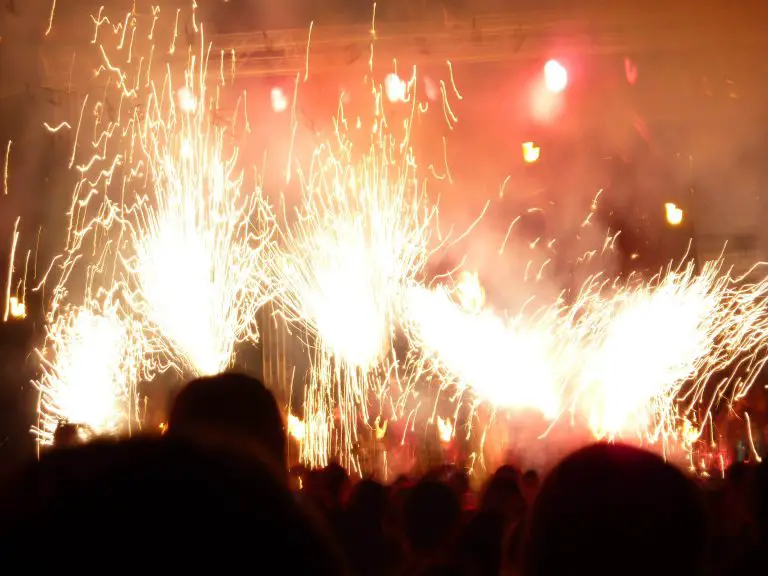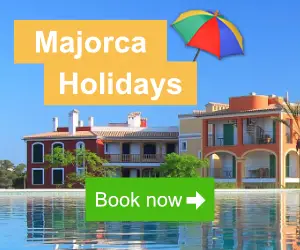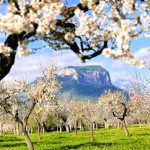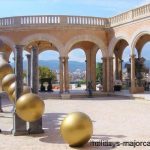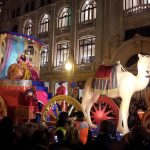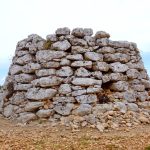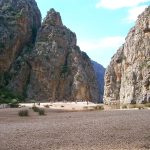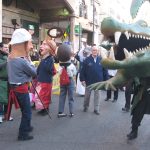Table of Contents
The San Antonio Festival is one of the most iconic & loved events in Majorca. Taking place every year on January 16th and 17th, this lively festival honours San Antonio Abad (Saint Anthony the Abbot), the patron saint of animals.
It celebrates Majorcan traditions and folklore while bringing together locals and visitors through food, music, dancing, and elaborate parades.
With roots dating back to 1365, the festival has many unique elements that showcase the agricultural history of the island. Visitors can expect to see spectacular bonfires filling the streets, wild demons parading around, blessings of animals in local churches, and delicious local cuisine cooked over open flames.
It offers the chance to immerse in authentic Majorcan culture and join the islanders in commemorating their beloved saint.
Dates and Location
Dates: January 16th to 17th, annually
Location: Towns across Majorca including Sa Pobla, Manacor, Artà, Pollença, Santanyí, and Algaida
Origins
The Sant Antoni festivities have their roots in celebrating Sant Antoni Abat (Saint Anthony the Abbot), an Egyptian Christian monk who lived an ascetic life in the desert during the 3rd and 4th century AD.
According to legend, Saint Anthony was faced with temptation from the Devil, who visited him disguised as a woman. In an attempt to resist, Anthony walked across hot coals, which is why bonfires became a symbolic part of the festival honouring him.
The festival’s origins can be traced back to the 14th century here in Mallorca, first documented in Sa Pobla in 1365. During medieval times, agriculture and livestock were vital to the island’s economy.
Locals relied heavily on working animals and would ritualistically bring them to be blessed every year around Saint Anthony’s Feast Day on January 17th, asking for protection. This animal blessing tradition remains an integral part of the festivities to this day.
Over the centuries, the religious feast expanded to incorporate Mallorcan folklore and creative expression. The symbolic demon effigies and fiery runs were added, turning the humble blessings into a larger celebration of Mallorcan culture that continues to evolve while upholding beloved traditions. The Sant Antoni festivities truly showcase the heart and resilience of the Mallorcan people.
Overview

The San Antonio Festival infuses Majorcan towns with contagious festive spirit. During the day on January 16th, locals prepare elaborate costumes and floats for the parades taking place in the evening. The streets fill with the sound of traditional ximbombes, a type of friction drum, as musicians go from bonfire to bonfire.
As night falls, large bonfires are lit in town squares and streets, culminating in over a hundred bonfires in Sa Pobla alone. Locals gather around the crackling flames with friends and family, roasting sobrassada sausage, botifarra sausage, and local vegetables while sipping on Mallorcan wine.
The key event is the spectacular demons dance performed by locals dressed as demons, representing the devils who tempted Saint Anthony.
With pitchforks, horns, tails, and red costumes, the dramatic performers chase and play tricks on spectators. The haunting smoke and glowing bonfires provide an eerie backdrop as they dance to the beat of the ximbombes.
The religious celebrations take place on January 17th, with domesticated animals brought to local churches to receive blessings from the resident priest. Town squares fill with proud owners and their chickens, dogs, horses, and other farm animals awaiting their yearly blessing.
Highlights
- Mesmerising bonfires and demon dances
The extravagant demon dances around the ubiquitous bonfires are a trademark of this festival. The performers embody an important symbolic ritual of dispelling evil spirits and bad omens through the purifying smoke and flames. Locals spend all year perfecting their choreographed routines and elaborate handmade costumes and props. Visitors can feel the primal, magical atmosphere as they watch the hypnotic dances illuminated by the raging bonfires. - Animal blessings
One of the most iconic and beloved traditions of the festival is witnessing the yearly blessings of domesticated animals in front of local churches and town halls. It’s common to see dogs, cats, horses, donkeys, goats, chickens and an occasional parrot patiently awaiting their turn as the priest sprinkles them with holy water and recites prayers. For locals, it represents hopes for prosperity and protecting their livelihoods dependent on agriculture and farming. - Communal Bonfires & Barbecues
Locals gather around the large bonfires lining the streets to take part in torrades, which see an array of meats and vegetables grilled over the hot coals. It’s a communal affair, with everyone contributing ingredients and mingling over drinks. Botifarrons sausage, sobrasada, and roast potatoes are popular choices, alongside Mallorcan wine. The torrades go late into the night, accompanied by traditional ximbomba music and singing.
Must-Try Experiences
- Feast on traditional dishes like sobrassada, botifarra sausage, espinagada (spinach and pork pie), and sweet red pepper pastries roasted over the bonfires
- Sample Mallorquin wines as you watch the flamboyant demons’ dances illuminated by the crackling fires
- Wake up early to catch the animal blessings and see everything from dogs to chickens being sprinkled with holy water
- Join in with the ximbombes musicians as they walk from bonfire to bonfire
- Take photos with locals dressed in elaborate handmade costumes portraying demons, giants, or other folklore creatures
- Catch a Fire Run – Marvel at the daring correfocs runners as they sprint through streets emitting fireworks for an intense spectacle.
Shopping Opportunities
The festival offers visitors a chance to shop for quality artisanal products and handmade goods. Browse stalls selling traditional Mallorquin decorations, ceramics, bonfire logs etched with unique designs, embroidered accessories, carved walking sticks, figurines of demons made from olive wood, and iconic terracotta whistles shaped like demons and saints.
You can also purchase sobrassada, botifarra sausage, and sweet Majorcan wine to take home as edible souvenirs. For a unique memento, have your name engraved on a personalized ximbomba friction drum.
Tips for Visitors
Getting There: Tourists staying in popular destinations like Palma can take buses organised by travel agencies that drop off directly at the festival locations. Visitors exploring the island by rental car can easily drive to towns holding major celebrations.
Accommodation: Hotels get booked months in advance in places like Sa Pobla. Reserve early or consider vacation rentals in nearby villages. Travel agencies also offer affordable packages including accommodation, amenities, and event tickets.
Local Etiquette: Be respectful during religious ceremonies and animal blessings. While the festivities have a lively atmosphere, keep noise levels down late at night and clean up after yourself.
Additional Information
The festival dates back to the 14th century when Majorca’s rural economy centred around agriculture. The blessings represent hopes for protecting livestock essential for farming and nourishment.
While events take place across the island, the most spectacular celebrations are in Sa Pobla, Manacor, and Artà.
Check local listings for specific timings and any last-minute changes. Most events are outdoors, so be prepared for crowds and bring warm layers for chilly January nights.
Conclusion
The San Antonio Festival offers a vibrant glimpse into authentic Majorcan traditions and local culture. The dazzling parades and dances, solemn blessings, mouthwatering cuisine, and infectious festive mood make it an unforgettable experience. Visitors can bond with locals over a shared delight in upholding beloved island customs.
Beyond the symbolic rituals, at its heart, the festival is a community celebration of life’s simple pleasures – food, music, dance, and companionship. Attending the San Antonio Festival lets you temporarily become part of the island’s rich heritage and make long-lasting memories embracing the Majorcan lifestyle.

Mark Kaye is a travel writer and content creator living in Majorca, Spain. Originally from the UK, Mark moved to the island and quickly fell in love with Majorcan culture, food, and scenic landscapes. When he’s not busy writing detailed guides about Majorca’s top tourist attractions and hidden local gems, you can find him out exploring coastal trails or wandering the streets of Palma’s Old Town in search of his next great restaurant discovery.

